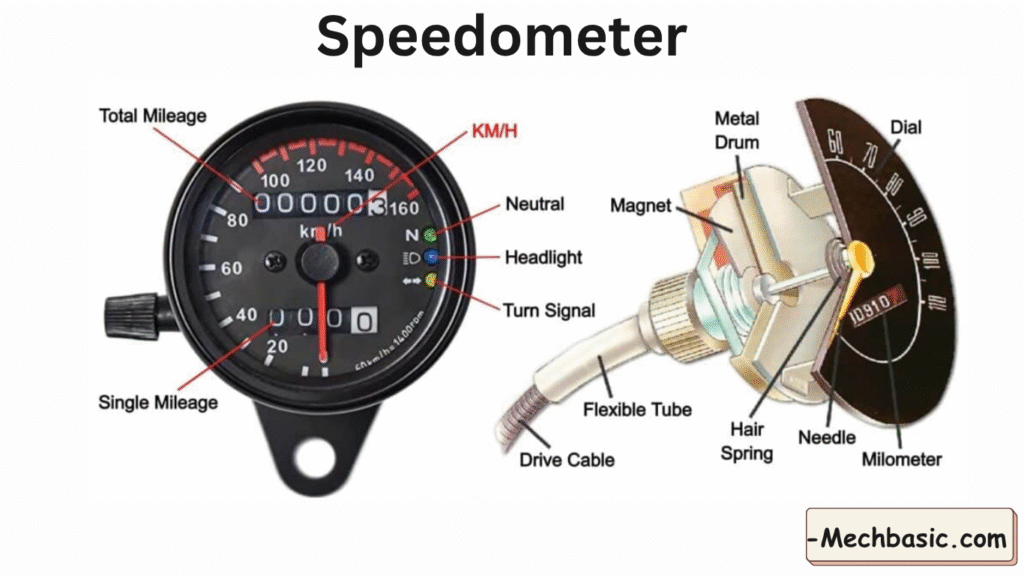
1. What is a Speedometer?
A speedometer is an instrument in a vehicle that measures and displays the vehicle’s speed in real time.
- Usually located on the dashboard in front of the driver.
- Provides speed in kilometers per hour (km/h), miles per hour (mph), or both.
- Modern vehicles may also display speed digitally on a digital instrument cluster.
2. Purpose of a Speedometer
- Monitor Vehicle Speed: Helps the driver maintain safe and legal speeds.
- Safety Compliance: Ensures adherence to speed limits, reducing accident risk.
- Fuel Efficiency: Helps in maintaining optimum speed for fuel economy.
- Integration with Other Systems: Feeds speed data to systems like:
- Cruise control
- ABS (Anti-lock Braking System)
- Traction control
- Speed limiter in modern vehicles
3. Types of Speedometers
A. Mechanical (Analog) Speedometer
- Uses a cable connected to the transmission.
- The cable rotates a magnet, which spins a needle on the dial.
- Features:
- Simple and robust
- Gradual needle movement
- No electrical power required
B. Electronic / Digital Speedometer
- Uses vehicle speed sensors (VSS) on the transmission or wheel.
- Sends electrical pulses to a digital display or analog gauge.
- Features:
- Accurate at all speeds
- Can integrate with digital dashboards
- Often includes additional info: trip meter, fuel efficiency, cruise control
C. GPS-Based Speedometer
- Uses satellite signals to calculate speed.
- Highly accurate on straight roads.
- Useful in modern smart cars and EVs, sometimes integrated with navigation systems.
4. Components of a Speedometer
| Component | Function |
|---|---|
| Speed Sensor / Vehicle Speed Sensor (VSS) | Detects rotation of transmission or wheel |
| Cable or Electronic Circuit | Transfers motion or pulses to the speedometer |
| Display / Dial | Shows speed in km/h or mph |
| Needle / Pointer | Analog indication of speed (mechanical or electronic) |
| Digital Display | Shows speed numerically in digital speedometers |
| Trip Meter / Odometer | Tracks distance traveled |
5. How a Speedometer Works
Mechanical Speedometer
- Transmission output shaft spins a flexible cable.
- Cable rotates a magnet inside the speedometer housing.
- The magnet induces motion in the needle, moving across the speed dial.
Electronic Speedometer
- Vehicle speed sensor (VSS) generates electrical pulses proportional to wheel rotation.
- Pulses are sent to ECU or speedometer circuit.
- Display shows speed digitally or drives an analog needle.
6. Common Problems with Speedometers
- Stuck needle or display not moving.
- Erratic readings due to faulty speed sensor.
- Cable wear or breakage in mechanical speedometers.
- Incorrect calibration after tire/wheel size changes.
- Electrical issues in digital speedometers (blown fuse, bad wiring).
7. Importance of a Speedometer
- Safety: Helps driver maintain safe speed in different conditions.
- Legal Compliance: Prevents speeding violations.
- Vehicle Health: Helps maintain fuel efficiency and engine longevity.
- Integration: Provides data for modern vehicle systems like cruise control, ABS, and adaptive systems.
✅ Summary
- Speedometer = instrument to measure vehicle speed.
- Types: Mechanical (cable-driven), electronic (VSS-based), GPS-based.
- Components: Sensor, display, needle/digital screen, trip meter.
- Purpose: Safety, legal compliance, fuel efficiency, integration with other vehicle systems.
💡 Tip:
Mechanical speedometers can lose accuracy over time due to cable wear, while electronic and GPS-based speedometers are more precise and integrate easily with modern vehicle systems.
FAQ Section:
Here are 10 frequently asked questions (FAQs) about a Speedometer:
- What is a Speedometer?
A speedometer is an instrument in a vehicle that displays the current speed at which the vehicle is traveling. - How does a Speedometer work?
It works mechanically using a rotating cable or electronically using sensors to measure wheel or transmission rotation. - What are the types of Speedometers?
The main types are mechanical (cable-driven) and electronic (digital or sensor-based) speedometers. - Why is the Speedometer important?
It helps drivers maintain safe speeds, obey traffic laws, and monitor vehicle performance. - Can a Speedometer be inaccurate?
Yes, inaccuracies can occur due to tire size changes, calibration errors, or sensor issues. - What units does a Speedometer show?
It typically shows speed in kilometers per hour (km/h) or miles per hour (mph). - How do digital speedometers work?
They use electronic sensors on the transmission or wheels and display speed digitally on a screen. - Can a faulty Speedometer affect driving?
Yes, it may lead to speeding violations, poor fuel management, or unsafe driving conditions. - Is it possible to calibrate a Speedometer?
Yes, calibration can be done mechanically or electronically to ensure accurate readings. - Do all vehicles have a Speedometer?
Yes, it is a standard instrument in almost all vehicles for safety and legal compliance.
Other courses:



